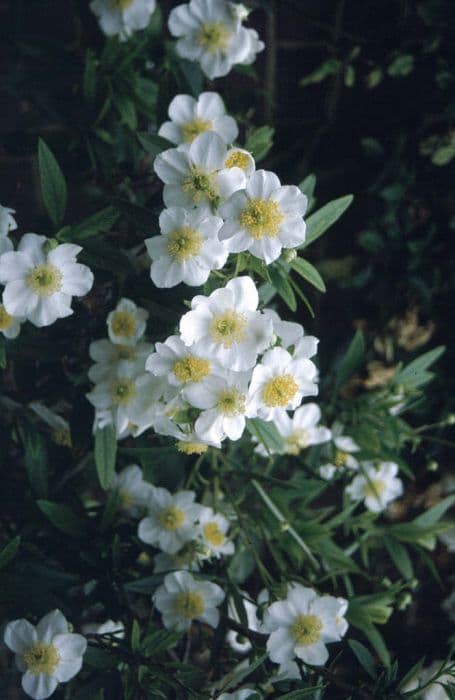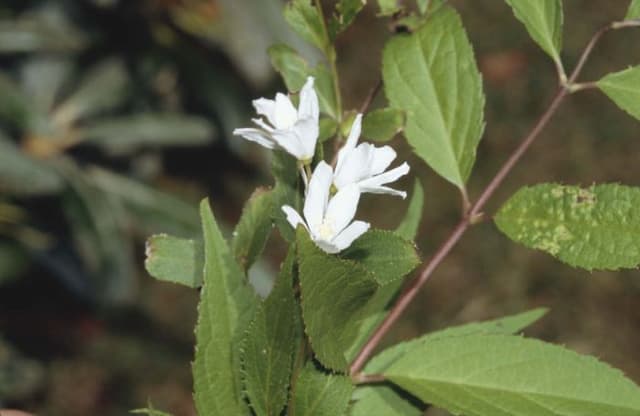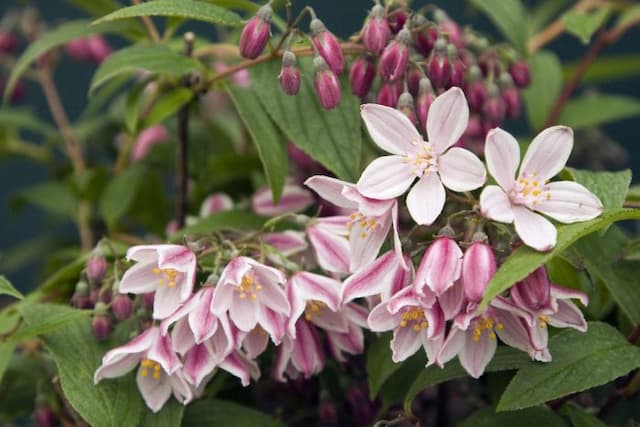Bigleaf Hydrangea Hydrangea macrophylla 'Mariesii Grandiflora' (L)

ABOUT
Hydrangea macrophylla 'Mariesii Grandiflora', commonly known as the bigleaf hydrangea, is a striking ornamental plant renowned for its showy flowers. It boasts large, rounded flower heads that bloom in a broad spectrum of colors, from vibrant pink to deep blue, depending on the soil pH. The petals of each flower are tightly packed into a dense, globe-like cluster, creating a pom-pom effect that is both elegant and eye-catching. The bigleaf hydrangea displays glossy, dark green leaves that provide a lush backdrop for the vivid blooms. These leaves are broad and ovate with a slight toothiness to their margins adding texture to the plant's overall appearance. The contrast between the vibrant flowers and the rich green foliage makes this hydrangea a prominent feature in gardens and landscapes. The plant has a bushy habit, with stems that arch gracefully under the weight of the blooms, creating a rounded silhouette that enhances its visual impact.
About this plant
 Names
NamesSynonyms
Bigleaf Hydrangea, French Hydrangea, Lacecap Hydrangea, Mophead Hydrangea, Penny Mac, Hortensia.
Common names
Hydrangea macrophylla var. mariesii (Wilson) Rehder, Hydrangea mariesii Wilson.
 Toxicity
ToxicityTo humans
The Hydrangea, particularly Hydrangea macrophylla 'Mariesii Grandiflora', does contain compounds that are toxic to humans when ingested. These include cyanogenic glycosides, which can release cyanide when the plant material is chewed or digested. Symptoms of poisoning from hydrangeas can include stomach upset, nausea, vomiting, and diarrhea. In higher amounts, the toxicity can lead to more severe symptoms such as dizziness, difficulty breathing, and in extreme cases, convulsions or coma due to the cyanide's effect of preventing oxygen utilization by the cells.
To pets
The Hydrangea, including Hydrangea macrophylla 'Mariesii Grandiflora', is also toxic to pets such as dogs and cats. The plant contains cyanogenic glycosides that can release cyanide when digested, posing a risk if pets chew or ingest any part of the plant. Symptoms of poisoning in pets may include vomiting, diarrhea, lethargy, abdominal pain, and depression. In severe cases, ingestion can lead to increased heart rate, labored breathing, seizures, coma, and even death. Immediate veterinary attention is advised if a pet has ingested any part of a hydrangea plant.
 Characteristics
CharacteristicsLife cycle
Perennials
Foliage type
Deciduous
Color of leaves
Green
Flower color
Varies
Height
4-6 feet (1.2-1.8 meters)
Spread
4-6 feet (1.2-1.8 meters)
Plant type
Shrub
Hardiness zones
6
Native area
Japan
Benefits
 General Benefits
General Benefits- Enhances Garden Aesthetics: With its large, showy flowers, Mariesii Grandiflora adds dramatic visual interest to gardens and landscapes.
- Attracts Pollinators: The flowers provide a nectar source for bees and other pollinators, supporting local ecosystems.
- Seasonal Interest: It offers a long blooming period from late spring to early autumn, contributing to garden color for an extended time.
- Versatile Landscaping: Can be used in various landscaping designs, including borders, hedge plants, or as a stand-alone specimen.
- Color Variety: The blooms can change color based on the soil pH, adding a unique and diverse element to garden hues.
- Durable: It's a hardy plant that can tolerate a variety of conditions once well-established.
- Can be Grown in Containers: Suitable for patio or deck gardening, allowing those with limited space to enjoy its beauty.
 Medical Properties
Medical PropertiesThis plant is not used for medical purposes.
 Air-purifying Qualities
Air-purifying QualitiesThis plant is not specifically known for air purifying qualities.
 Other Uses
Other Uses- Floral Arrangements: Hydrangea is popularly used in dried floral arrangements due to its large, colorful blossoms that dry gracefully and retain color.
- Garden Accents: These plants are also used as striking garden accents, often planted to create a focal point because of their voluminous flower heads.
- pH Indicator: The flowers of the hydrangea can indicate the pH level of the soil they are grown in—blooming in shades of pink in alkaline soils and blue in more acidic soils.
- Artistic Inspiration: The diverse range of hues found in hydrangea petals makes them a frequent subject of study and inspiration for artists and photographers.
- Tea Infusion: In some cultures, hydrangea leaves are used to make a sweet tea called 'ama-cha' which is consumed during the Buddha bathing ceremony in Japan.
- Crafts: The wood of hydrangeas can be used to make small intricate items such as jewelry or ornamental pieces.
- Education and Study: Hydrangeas are often used in educational environments for botanical studies because of their unique flower formation and color changing properties.
- Soil Erosion Control: Their extensive root system can stabilize sloping gardens and hillsides, helping prevent soil erosion.
- Festive Decor: During holidays, hydrangeas are used as decor due to their full, vibrant blooms which complement festive themes.
- Plant Breeding: Hydrangea is used in breeding programs to create new varieties with unique colors, flower shapes, and garden hardiness.
Interesting Facts
 Feng Shui
Feng ShuiThe Lacecap Hydrangea is not specifically used in Feng Shui practice.
 Zodiac Sign Compitability
Zodiac Sign CompitabilityThe Lacecap Hydrangea is not used in astrology practice.
 Plant Symbolism
Plant Symbolism- Heartfelt and Sincere Emotions: Hydrangeas are often associated with deep, heartfelt emotion due to their lush and abundant flowerheads.
- Gratitude: The generous bloom size can symbolize gratitude, making the flower a popular gift to express thanks.
- Understanding: Giving someone hydrangeas can represent a desire to be understood or an expression of the giver's comprehension of the recipient's feelings.
- Apology: In some contexts, hydrangeas can signify an apology or a desire for forgiveness.
- Boastfulness or Vanity: Due to the showy nature of their flowers, hydrangeas can sometimes represent boastfulness or vanity.
- Abundance: The hydrangea's lavish blooms can symbolize abundance and prosperity.
- Beauty: The plant is often associated with beauty, both due to its appearance and its ability to change color based on the soil pH.
 Water
WaterBigleaf Hydrangeas, including the 'Mariesii Grandiflora', require consistent moisture and should be watered deeply, ensuring the root zone is thoroughly soaked. During the growing season, watering should occur two to three times per week, depending on weather conditions. If the plant is established and in the ground, it may need approximately 1 gallon of water each time. In hot or windy weather, more frequent watering might be necessary to prevent wilting. Reduce the frequency to once a week during cooler temperatures or in fall. Overhead watering can lead to leaf spots, so it's best to apply water directly to the base of the plant.
 Light
LightBigleaf Hydrangeas, like 'Mariesii Grandiflora', thrive in morning sun and afternoon shade. They can also grow well in dappled sunlight throughout the day. Avoid exposing the plant to full afternoon sun, especially in hotter climates, as this can stress the plant and lead to leaf scorch.
 Temperature
TemperatureBigleaf Hydrangeas prefer moderate temperatures and can generally tolerate a range from 60 to 75 degrees Fahrenheit as ideal growing conditions. The 'Mariesii Grandiflora' can survive minimum temperatures down to around 20 degrees Fahrenheit but should be protected from frost. During winter, mulching can help insulate the roots from extreme cold.
 Pruning
PruningBigleaf Hydrangeas like 'Mariesii Grandiflora' should be pruned to remove dead wood and to shape the plant, usually after the blooms fade, but not past August, as they flower on old wood. Pruning can be done yearly. If rejuvenation is needed, cut back one-third of the oldest stems almost to the base in late winter.
 Cleaning
CleaningAs needed
 Soil
SoilBigleaf Hydrangea prefers moist, well-draining soil rich in organic matter with a pH ranging from 5.5 to 6.5. An ideal soil mix for this plant can be made by combining 1 part garden soil, 1 part peat moss, and 1 part perlite or coarse sand to ensure adequate drainage and aeration, which is essential for healthy root development.
 Repotting
RepottingBigleaf Hydrangeas don't require frequent repotting and can be repotted every 3-5 years or when they outgrow their current container. It's best to repot in the spring before active growth begins, using a fresh, appropriate soil mix that matches the plant's requirements.
 Humidity & Misting
Humidity & MistingBigleaf Hydrangea thrives in an environment with high humidity, ideally above 50%. If indoor air is too dry, misting the leaves or placing a humidifier nearby can help maintain the optimum humidity levels for healthy growth.
 Suitable locations
Suitable locationsIndoor
Keep in bright, indirect light with high humidity and water regularly.
Outdoor
Plant in semi-shade, water often, and protect from strong winds.
Hardiness zone
6-9 USDA
 Life cycle
Life cycleHydrangea macrophylla 'Mariesii Grandiflora', commonly known as bigleaf hydrangea, begins its life cycle when dormant flower buds develop during the summer months for the following spring. In the early spring, new shoots emerge from the base of the plants or from surviving stems, and the plant experiences vegetative growth, producing large, broad leaves. As temperatures increase and the plant receives adequate moisture and nutrients, it enters the bloom stage in late spring to summer, showcasing large, lacecap flowers. After the flowering period, the plant sets seed, although propagation is more commonly achieved through cuttings. Throughout the fall, the hydrangea prepares for dormancy, with leaves changing color and eventually falling as temperatures drop. During the winter months, it remains dormant with minimal physiological activity, conserving energy for the next growing season.
 Propogation
PropogationPropogation time
Spring to early summer
The most popular method for propagating the Hydrangea macrophylla 'Mariesii Grandiflora,' commonly known as the lacecap hydrangea, is through softwood cuttings. This is typically done in late spring or early summer when the plant's new growth is just beginning to harden but is still flexible. Gardeners take cuttings that are about 5 to 6 inches (approximately 12.7 to 15.2 cm) long, making sure each cutting has several leaves and at least one node. The lower leaves are removed, and the cut end is dipped in rooting hormone before the cutting is placed in a well-draining potting mix. To maintain high humidity, the cutting can be covered with a plastic bag or placed in a propagator. Regular misting helps prevent the leaves from drying out. Roots usually develop within a few weeks, after which the new hydrangea can be transferred to a larger pot or planted directly into the garden.







![Hydrangea [Strong Annabelle]](/_next/image?url=https%3A%2F%2Fplants-admin.emdemapps.com%2Fimages%2Fplants%2F%2Fimages%2F604b54db37d34.png&w=640&q=75)

